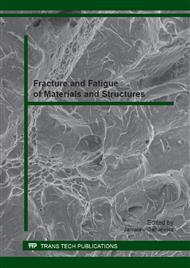[1]
S.R. Thompson, J.J. Ruschau, T. Nicholas, Influence of residual stresses on high cycle fatigue strength of Ti–6Al–4V subjected to foreign object damage, International Journal of Fatigue 23 (2001) 405–412.
DOI: 10.1016/s0142-1123(01)00166-9
Google Scholar
[2]
J.O. Peters, R.O. Ritchie, Influence of foreign-object damage on crack initiation and early crack growth during high-cycle fatigue of Ti–6Al– 4V, Engineering Fracture Mechanics 67 (2000) 193–207.
DOI: 10.1016/s0013-7944(00)00045-x
Google Scholar
[3]
D. Nowell, D. Dini, P. Duo, Stress analysis of V-notches with and without cracks, with application to foreign object damage, Journal of Strain Analysis 38 (2003), 1–13.
DOI: 10.1243/03093240360713487
Google Scholar
[4]
L. Witek, Numerical stress and crack initiation analysis of the compressor blades after foreign object damage subjected to high-cycle fatigue, Engineering Failure Analysis 18 (2011) 2111-2125.
DOI: 10.1016/j.engfailanal.2011.07.002
Google Scholar
[5]
L. Witek, Crack propagation analysis of mechanically damaged compressor blades subjected to high cycle fatigue, Engineering Failure Analysis 18 (2011) 1223–1232.
DOI: 10.1016/j.engfailanal.2011.03.003
Google Scholar
[6]
L. Witek, Fatigue analysis of the compressor blades with v-notches, in: Structural Integrity: Influence of efficiency and green imperatives, Springer, Montreal, 2011, pp.721-734.
DOI: 10.1007/978-94-007-1664-3_57
Google Scholar
[7]
L. Witek, Stress intensity factor calculations for the compressor blade with half-elliptical surface crack using Raju-Newman solution, in: Fatigue of Aircraft Structures Monographic Series, Versita, Warsaw, 2011, 153-164.
DOI: 10.2478/v10164-010-0046-2
Google Scholar
[8]
L. Witek, M. Orkisz, P. Wygonik et al. Fracture analysis of a turbine casing, Engineering Failure Analysis 18 (2011) 914-923.
DOI: 10.1016/j.engfailanal.2010.11.005
Google Scholar
[9]
L. Witek, Failure analysis of the wing-fuselage connector of an agricultural aircraft, Engineering Failure Analysis 13 (2006) 572-581.
DOI: 10.1016/j.engfailanal.2004.12.029
Google Scholar
[10]
P. B. Michailov, Sprawocznik po metaliczeskim matierialam turbino- i motorostroenija, Sankt Petersburg, 1961.
Google Scholar
[11]
MSC-PATRAN-2004 Users Manual, MSC Corporation, Los Angeles, 2004.
Google Scholar
[12]
ABAQUS ver. 6.9 Users Manual, Abaqus Inc., 2009.
Google Scholar
[13]
M. Wierzbińska, A. Poznańska, L. Witek, Fracture analysis of compressor blade of a helicopter engine, Engineering Failure Analysis 16 (2009) 1616-1622.
DOI: 10.1016/j.engfailanal.2008.10.022
Google Scholar


